Cardesign since 1899
The appearance of automobiles was and is always subject to several influences: contemporary tastes and technical limitations (or further developments) are just two of these influences. Often there are also trends created by the manufacturers‘ marketing departments – let’s just think of the buggies of the 1960s, the cabriolets that kept appearing and, recently, the massive advance of SUVs into automotive living spaces.
In the following I present models for each decade since 1890, which in my opinion are exemplary for the respective decade. Each picture can be viewed in large size with a click, the models are linked under each picture with their respective individual page on this website or on my Opel model page.
The type of model presentation tries to reflect the spirit of the respective epoch by means of style elements typical of that time.
1890-1899
The cars were more like horseless carriages – this was also reflected in the design. Unfortunately, there is only one contemporary framed drawing of the “Opel Patentmotorwagen System Lutzmann” shown here.
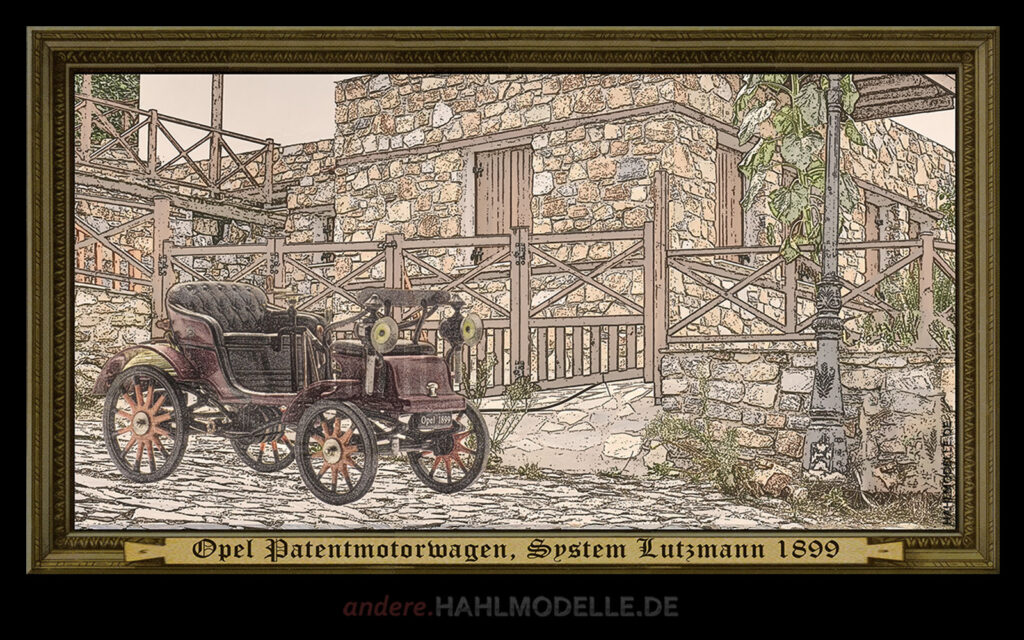
1900-1910
Many cars were manufactured more efficiently in their basic components than in the early years, but the manufacturers were still a long way from series production. The shape of the cars began to standardize a little (four wheels, engine often in front, seats facing the direction of travel). For a number of models there was only a chassis and engine; the body was often the responsibility of the customer who commissioned another company. The first commercial vehicles rattled on the bumpy streets.
Unfortunately, I only have a yellowed photo of a delivery van from that time and only fragments of a typical newspaper advertisement of the underlying model.
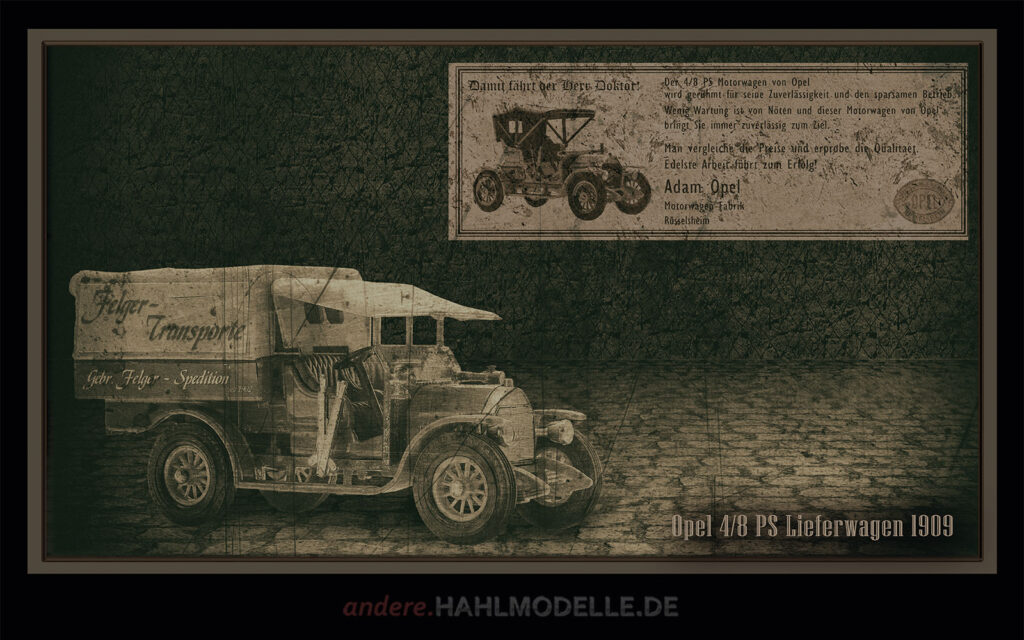
1910-1919
The cars have slowly developed further, the basic construction of frame / chassis plus engine plus body on top is still unchanged. This of course offers space for extravagant body shapes – here a landaulet. (And finally as a „studio picture“ from the present – but with decorative elements typical of that time.)
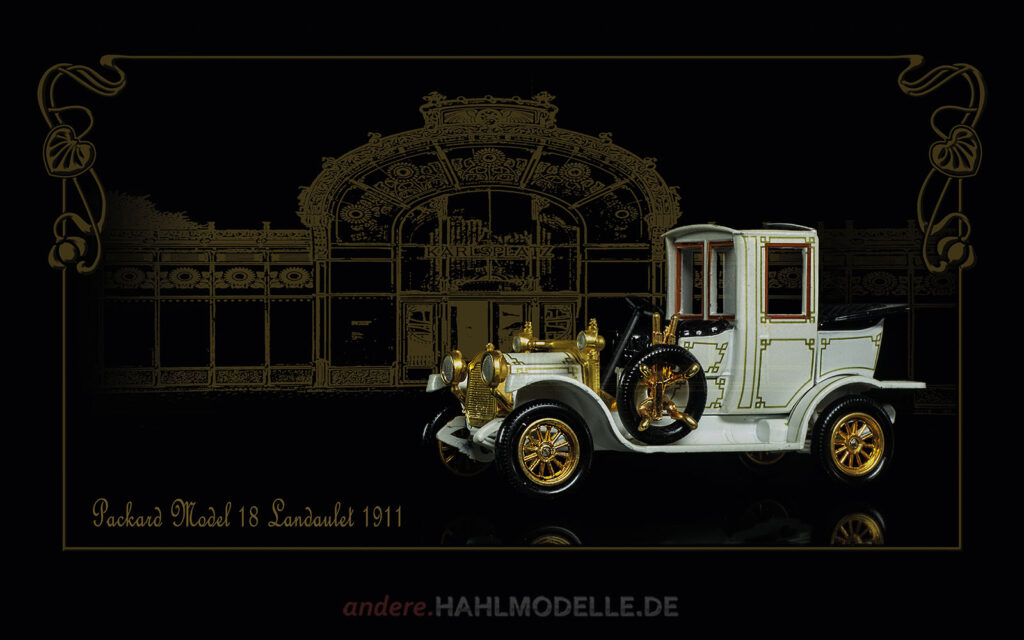
1920-1929
The political reorganization of the „old world“ after the war led on the one hand to profound upheavals in the social structure of the previous social systems and on the other hand to the consolidation and expansion of already existing assets. Technologically, the war had brought about a boost in the development of many things and at the same time art (and thus parts of automobile design) experienced a new freedom and new possibilities. For the masses, there were simple automobiles with robust and easy-to-maintain technology, and many of these automobiles ran off the first assembly lines in large numbers in a more or less standardized manner. For the wealthy, there were chassis and engines with insane power, and noble automobile couturiers tailored sheet metal clothes of breathtaking beauty or extravagance – or both.
And since I had two absolute upper-class models of the time in the studio, I also staged them in a correspondingly „noble“ way using the (stylistic) means of the present.
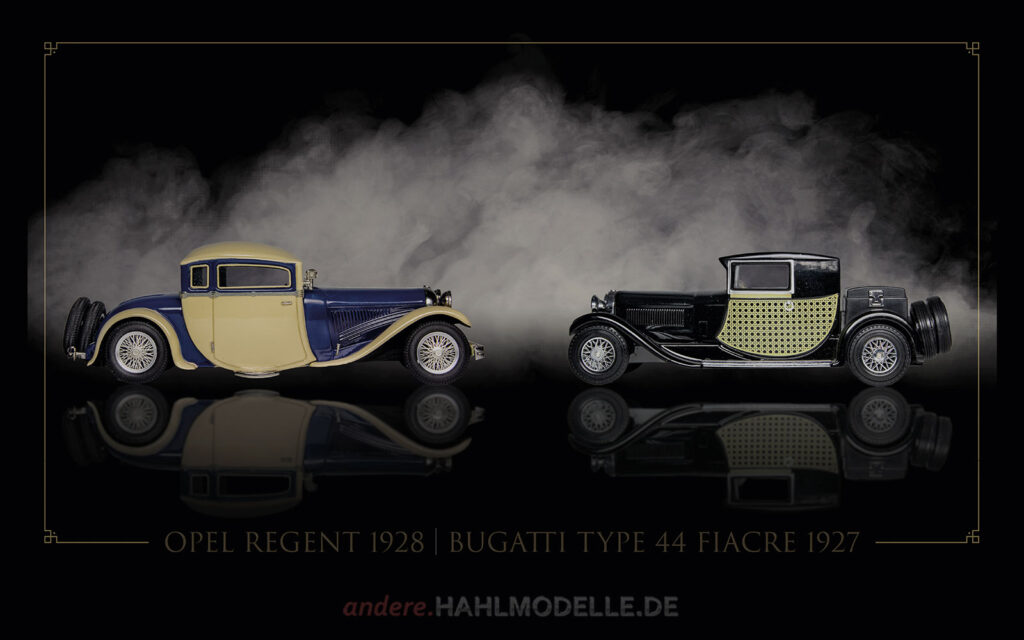
1930-1939
The world recovered from the upheavals of the past two decades, and within the social classes or in the regions where people were doing well, optimism about a “better world through technological progress” spread. For the automotive industry, this meant, above all, that a noticeable beginning of a comprehensive individual motorization was possible through cost-effective production in large numbers. At the same time, an increasingly better infrastructure was created in order to be able to use motorization in a targeted manner. Individualized luxury products were still to be found at the upper end of the scale. And motorsport also changed in its characteristics: While earlier competitions were intended to demonstrate the reliability and / or superiority of the automobile, the focus now shifted more and more towards sporting recognition – the reliability of the automobile was generally accepted. And for these sporting ambitions of individual wealthy men (factory teams were not yet that important), the manufacturers brought out the smallest editions of models that knew how to impress with their engine performance. Comfort was secondary, the design followed the maxim “The car must look fast and powerful!”. It is no coincidence that streamlined cars from this decade are still well present in today’s memory.
Here I had two typical representatives of the sports cars of the time in front of the camera, quite simply in front of a motif typical of the time at the Chicago World’s Fair in 1934.
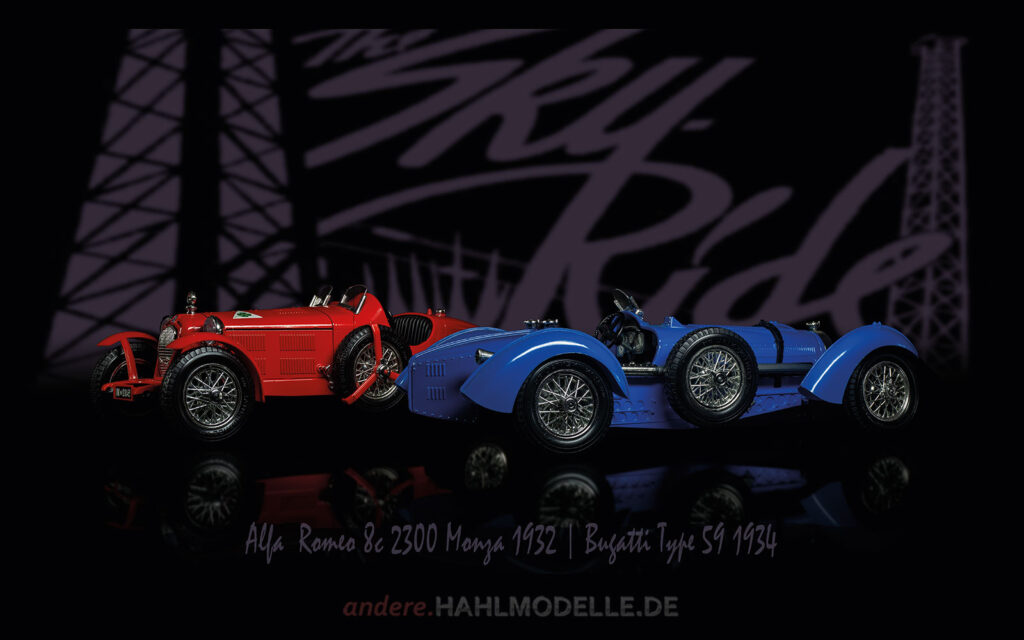
1940-1949
“Design” did not necessarily take place in Europe between 1940–1949 – due to the war. In the USA, too, the enormous economic output first had to be rededicated for civil purposes after the war. So it is not surprising that although technology had made a big leap in many things, the topic of „design“ wandered a little disoriented and, on the one hand, took recourse to the past decade and, on the other hand, anticipated with all its might a departure into new and technology-believing times. An example of this may be the architecture of that era, which took up elements of Art Deco and developed them further into a style that was christened “Modernistic” and, in later years, sometimes also called “Space Design”.
The first pontoon forms or their predecessors appeared in vehicle design. The large car groups that had formed in recent years – also through acquisitions of smaller competitors – expanded their range of products through initial group-wide standardizations and an apparent diversification through the forced formation of brands within a group. Shown here using the example of a Lincoln Zephyr Convertible parked in a setting typical of the time, which was on offer at Ford from 1940 – can be seen as a „scan“ from a photo album typical of the time.
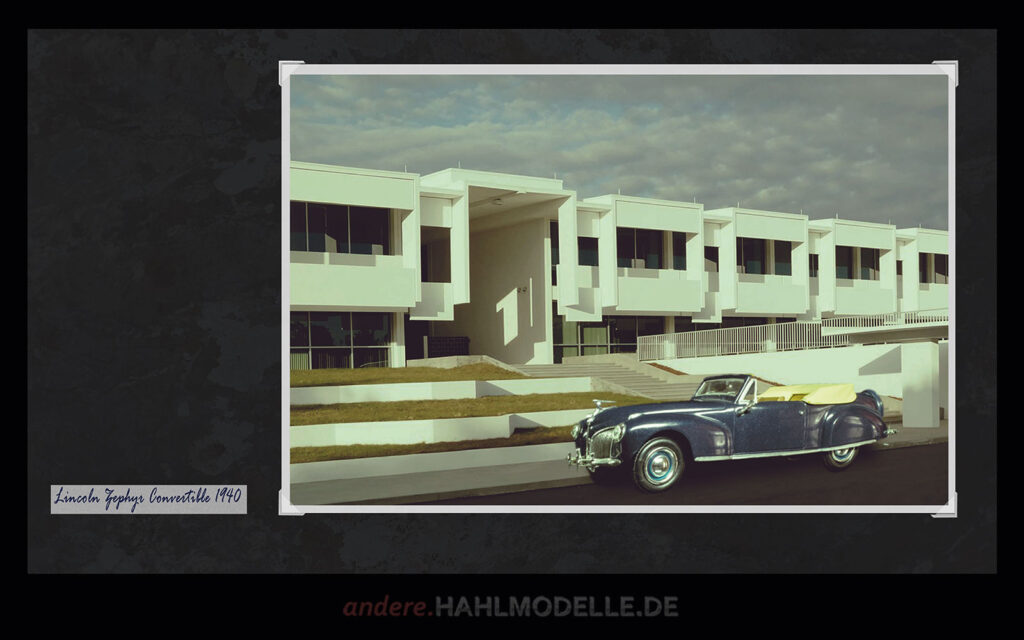
1950-1959
Let’s stay in the US for the next decade.
Here, technical innovations that made driving more comfortable, for example in the form of little electric helpers, were introduced. Electric window lifters, the first compact air conditioning systems, as well as trouble-free automatic transmissions were noteworthy representatives of these accessories, some of which were already found in mid-range vehicles. The other innovations of the large automotive groups, which are focused on high output, were otherwise limited to annual design changes of otherwise technically almost unchanged previous year’s models. This sometimes made a previous year’s model look relatively old next to its successor.
The design became more and more important to get cars sold and today it had strange flowers: Huge tail fins, panorama windows that distorted every look, and exuberant chrome jewelry shaped this era. Often borrowings from the „nozzle age“ were taken and pseudo air inlets and turbine outlets were stylistically modeled. This trend could also be observed in Europe – however, European automotive design only played a subordinate role. Automobile design became more and more an end in itself to get vehicles sold as „fashion accessories“. For the first time, the slogan „Form follows Function“ became popular in the counter-movement.
A typical representative of this era is staged in a matching color in front of a motel backdrop that is just as typical of the time.
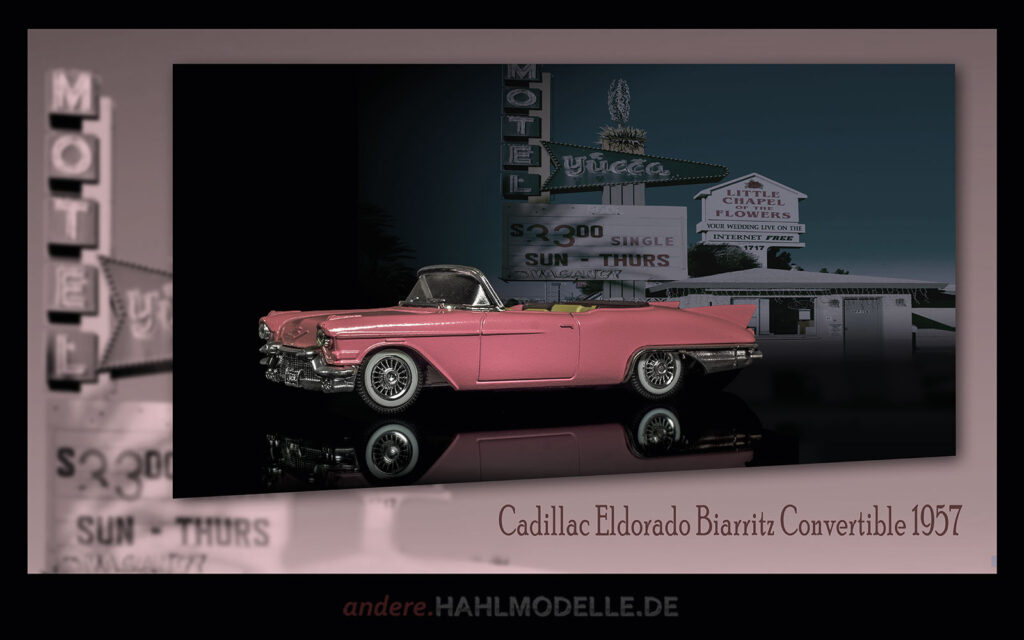
1960–1969
Let’s go back to Europe for the next decade. Here the new political order had stabilized to such an extent that the scars of the war gradually healed due to an economic upswing. Due to the steadily increasing prosperity of the middle class and also of the workforce, it was possible for the automobile manufacturers to cover their needs with new developments of vehicles and thus to introduce mass motorization in large parts of the old continent. On the one hand, outstanding sports cars with a breathtaking design were created, as well as a new type of small car that no longer looked like a “covered scooter” – as in the previous decade. Self-supporting bodies were now actually a matter of course and the first manufacturers were already experimenting with safety devices such as crumple zones or similar features. Stylistically, there was still no uniform European design language – at best a faster departure from American extravagance than on the other side of the Atlantic. A certain objectivity found its way into European design – but most vehicles could be assigned to a certain country very quickly due to their individual shape characteristics.
Here are two typical representatives from the „Swinging Sixties“ – photographed in a suitable, psychedelic backdrop. If you like, you can listen to the music of the early Pink Floyd while looking at the picture.
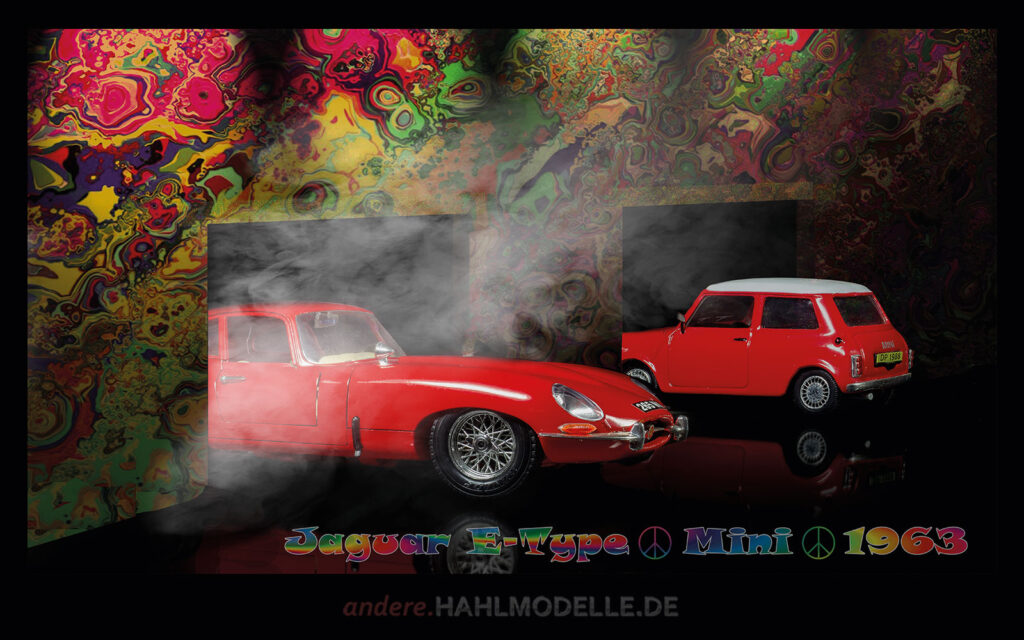
1970–1979
Let’s take a look at the decade from 1970–1979 and in particular the influences of international developments on German cars: While the basic mobilization needs in the mass market had gradually reached a certain degree of saturation, it was now crucial as sales support, further and different needs of the most diverse To satisfy groups of buyers on the basis of standardized models.
The technical fundamentals were largely the same globally: an engine at the front, the drive at the rear and a self-supporting body on top. For example, the decade before, the so-called “ponycars”, a genre of “hyper-sporty” coupés and fastback sedans, emerged in the USA, but this principle could not be transferred 1: 1 to the European or German market. The design in this country therefore continues the practicality of the previous years – „sportiness“ was delivered from the factory with decorative elements such as rally stripes or matt black bonnets plus entire batteries of additional headlights. So it is not surprising that the national offshoots of two of the „Big Three“ from Detroit brought models onto the market that were adapted to German conditions and were therefore very successful.
Opel achieved great success in this class with the first Manta as an affordable coupé based on existing large-scale production technology; the long-term rival from Cologne even launched a comparable model shortly beforehand, the “Ford Capri”. This car was available in a wide variety of engines and equipment variants – including major advertising successes in motorsport – and thus served a broad target group of potential buyers. Another German manufacturer – for lack of an American mother – went its own way: BMW. Since the economically successful „rebirth“ in the previous decade, they had a reputation for building sporty sedans. The highlight of this development was the “2002 turbo”, a crisp, compact notchback sedan of classic design with sporty genes and the “technical delicacy” of a turbocharger. The first oil crisis put an end to this development.
Two of the three cars mentioned can be seen here in front of elements typical of the time that could be found on the wallpaper of entire single-family housing estates…
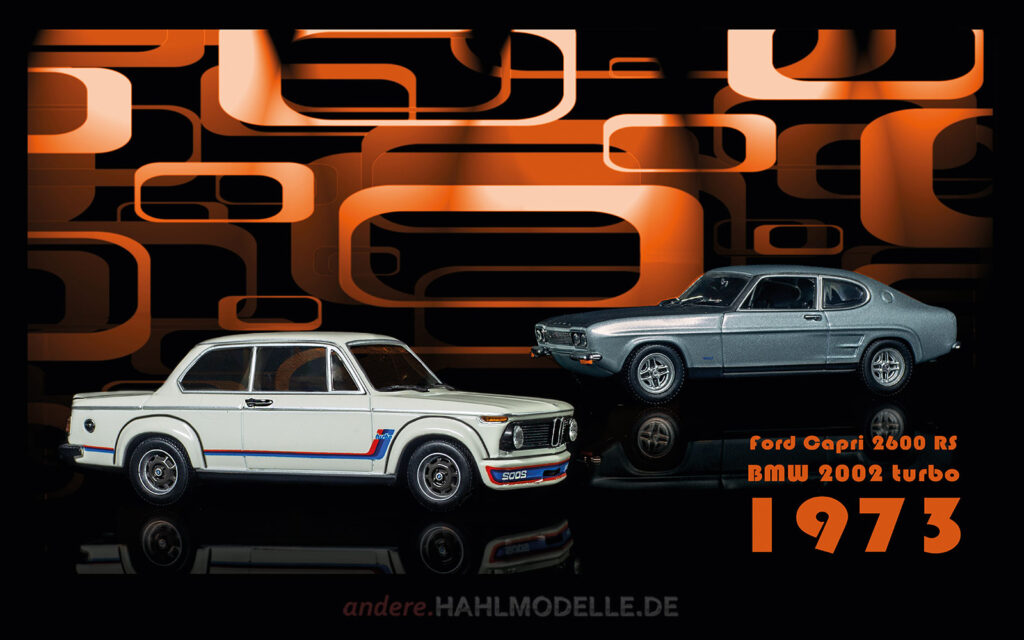
1980-1989
From the perspective of the time, the decade from 1980–1989 seems in parts disoriented, cold and flashy. From today’s perspective, we know that it was a decade of radical upheaval – politically and socially.
With the significant economic downturn caused by several oil price shocks in the previous decade and a change in consumer awareness, the automotive industry also had to take a different path. Practical vehicles with more reasonable consumption were in demand – the „Golf“ from Volkswagen had proven this as a newly established vehicle class and saved the VW Group from being finally destroyed. At the same time, the Japanese automotive industry was now making its mark on the European market – (still) lacking technical (and design) competence was compensated for by competitive prices and impressive equipment features. The European design was inspired by the “newly discovered aeroforms” – a type of design that had been tried a good 60 years earlier – but for different reasons then than now. More than ever, manufacturers of high-priced cars tried to set themselves apart from these trends by producing small editions of super sports cars. Only a few of them have actually been on the streets – most of them disappeared straight into the air-conditioned garages of wealthy collectors.
The model shown here shows one of the mentioned higher-priced models in a color backdrop typical of the time – „Miami Vice“ sends its regards…
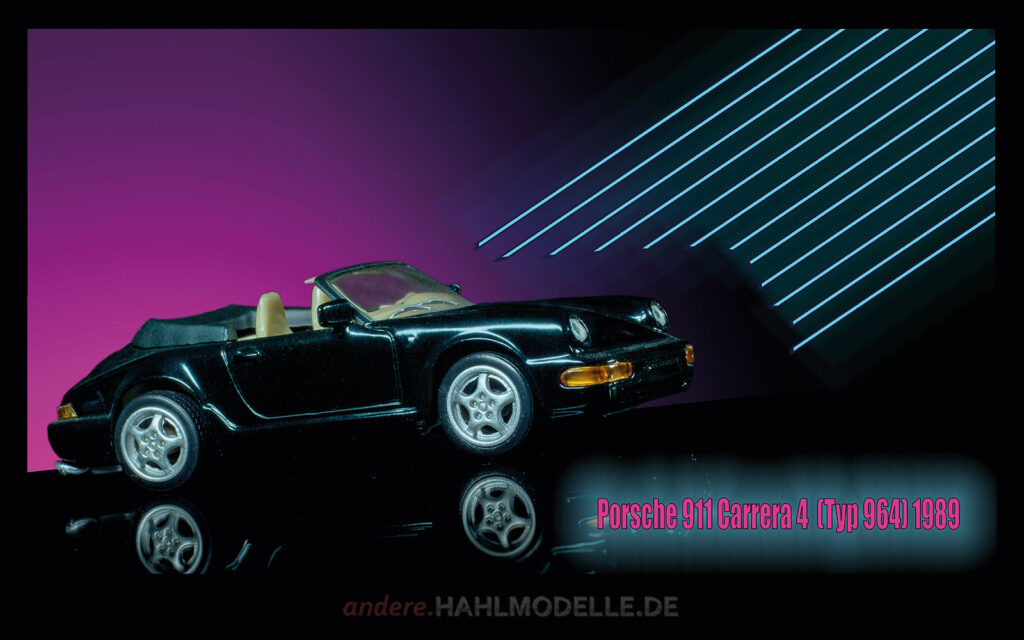
1990-1999
And then the period 1990–1999 – the last decade before the turn of the millennium had dawned. The global automotive industry has changed dramatically, but this time we only look at Japan:
The products of the local automotive industry had long been established in the major markets around the globe. In some cases, corresponding production lines were already running on the continents of Europe or America in order to be able to produce inexpensive and locally adapted versions of certain models. This was a great strength of the Japanese automotive industry: For the so-called „first world“ there were vehicles at low prices that corresponded to the wishes and equipment requirements of the local buyers. The technology was mature and very reliable – without having to hide from the models of regional providers. The same models were produced for markets in the “third world” in a version that was technically incomparably simpler and sometimes more robust. Repairs could be carried out easily without having to resort to special tools or electronic diagnostic instruments.
But Japan could also play in the upper league. This ability was impressively demonstrated, among other things, by a number of sports cars. In terms of design, Japan – apart from vehicles that were exclusively limited to its own market – was approaching generally accepted taste: vehicles could no longer be assigned to a particular country at first glance, design had become globalized.
Shown here is a typical example from this time – in an equally typical night street scene contaminated with graffiti.
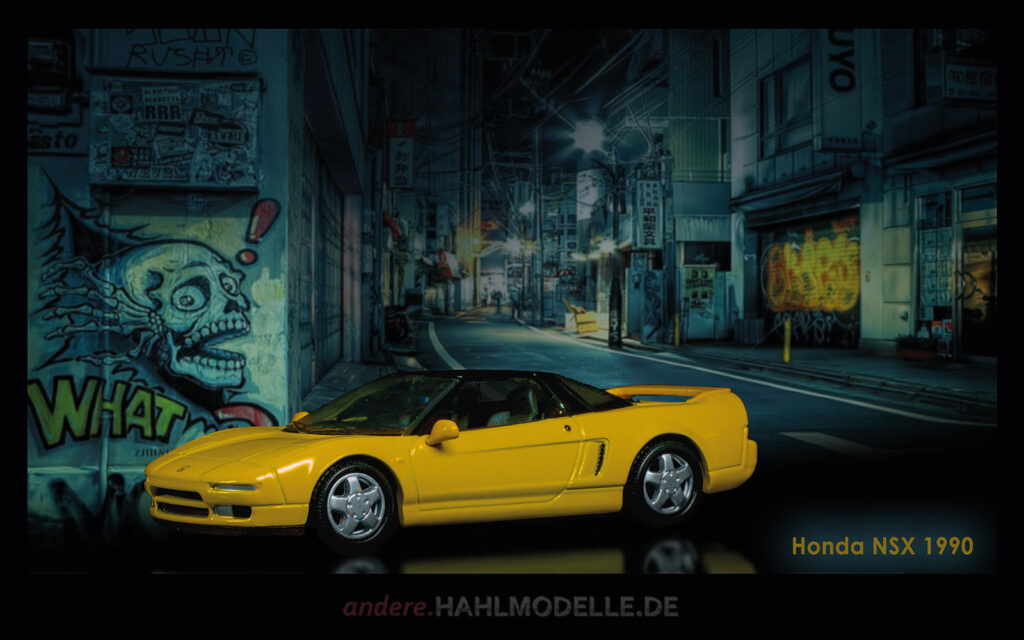
2000-2009
Everything was different in the new millennium, everything was new and better in the decade from 2000–2009. Everything? No, a small industry heroically defied innovation and resisted the passage of time.
While in the past decade in the automotive industry (almost) every manufacturer had done what one invented and then (almost) everyone else copied – namely Vans – the few large remaining corporations with their many brands now did what they wanted to sell people as a “lifestyle” or offer them as niche products for even the last buyer without a lease or credit. The banks with attached automobile production then pushed models into the market that no one needed, but many potential buyers were persuaded to do exactly the opposite. And so it is not surprising in retrospect that, for example, a renaissance of convertibles and roadsters could be experienced again. If they were previously under a downright ban on the (perceived) lack of security, this suddenly no longer played a role. However, the purism of earlier decades was no longer allowed to exist: little electric helpers everywhere, heat-blowing hairdryers at neck height, entertainment systems that put any private home theater in the shade, heated seats and steering wheels and even metal roofs that fold up fully automatically at the push of a button and in the trunk disappeared – who needs space for luggage? And because the thing had to be sold globally so that it did not have a negative effect on the shareholder value of the corporate owners, such a model was given a different name in each market and had the logo of a different brand in the radiator grille. And the design? Oh no matter, that somehow fits globally – who cares – the main thing it is stylish!
Here is a car from the USA, which was accidentally labeled “Opel” by overtired workers during a night shift and was therefore misleadingly offered as “Opel GT” in Germany – photographed in a setting based on PC games of the time.
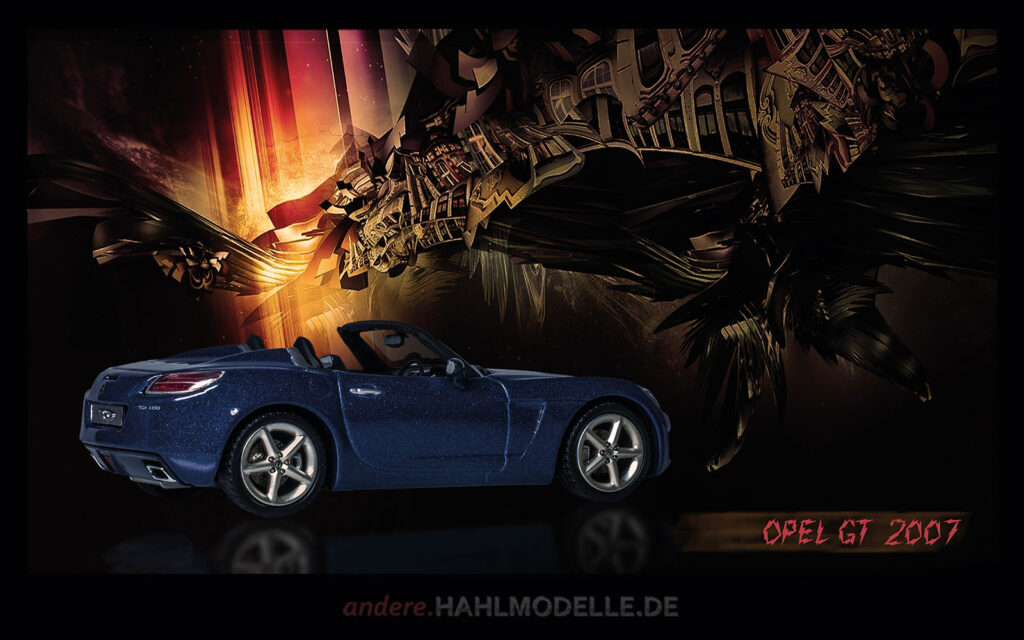
2010-2019
The second decade of the new century has dawned and we are nearing the end of it. Wage dumping, outsourcing and group-wide modular and platform strategies as well as sophisticated and very individual financing strategies do not help the automotive industry to put an end to the lagging behind the actual requirements. It continues to rely on outdated technology, which is elicited the last bit of performance by means of thousands upon thousands of permitted and also forbidden tricks – of course under the politically decreed requirement of being „green“.
Of course, cars are never “green” but “blue”. “Green” – that sounds too much like dungarees on bicycles and the automotive industry really doesn’t want anything to do with them – unless as a customer. But “blue” – that sounds modern, clean and stylish – and this is exactly how this industry sees itself. The fact that a product that is more than 100 years old is still being offered, which is largely produced in bypassing modern requirements, is vehemently denied and, if necessary, even manifested through state aid around the globe.
Of course, the manufacturers can also do it „electrically“. But then the design is made (on purpose?) so ugly that even the most well-meaning and financially potent buyers shudder away. Instead of using design possibilities and freedoms that could result from the elimination of internal combustion engines, transmissions and other elements, existing forms are retained – only that they are deliberately designed ugly. Some new manufacturers who rely exclusively on e-mobility show that design can be an exciting and practical thing for such products. Mainly, however, it seems that there are only so-called „Sports Utility Vehicles“ around the globe, the sportiest feature of which is often the thick rims and the „Utility“ of which is limited to occupying two spaces in the parking garage in the next city. But these have at least a combustion engine with a lot of power.
The model shown here also tried to flow in with an ugly and deliberately sales-inhibiting design under various brand and model names, so a blue-lit backdrop goes well with it.
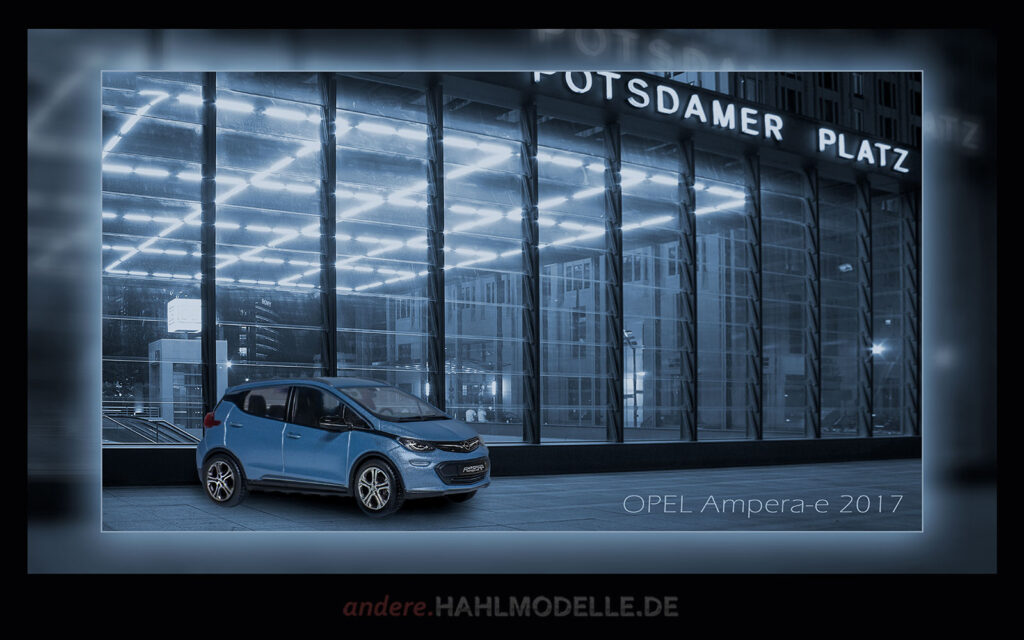
2020-2029
A new decade has now begun and the focus for the time being (as of early 2021) has shifted to the global Corona pandemic. For the automotive industry, changes in people’s mobility behavior do not promise too rosy prospects for the time being, and the call for electric mobility is getting louder and louder. The first group mergers are trying to meet these challenges with concentrated capital and resources – “Stellantis” (emerged from the merger of PSA and Fiat-Chrysler) is just one example. At the same time, new players (such as Tesla) are forcefully entering the market. Car sharing, “all-inclusive packages” on the supplier side and stricter environmental regulations on the political side provide further purchase incentives and purchase barriers alike. Everything is in a state of flux; important questions regarding the sustainability of electric cars and the safety of autonomous vehicles have not yet been clarified. To what extent these questions will influence the design of future cars remains to be seen. It is very certain that these issues will influence the design.
It remains exciting!
Advertising
All of the images shown here are collectively available as a representative wall calendar in various sizes and features.
The calendar is continuously updated.